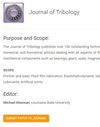Data-driven model of the distribution lubrication on water-lubricated bearing under severe operating conditions
IF 3
3区 工程技术
Q2 ENGINEERING, MECHANICAL
引用次数: 0
Abstract
To resolve the contradiction between the method used to design bearings based on traditional lubrication theory and the actual state of service of water-lubricated bearings (WLBs), this paper proposes a data-driven method for the model of the distribution of lubrication on WLBs. A full-sized WLB test bench featuring multi-sectional pressure due to the film of water and a system to measure the axis of the orbit was built to perform tests under severe operating conditions (75 kN, 25~220 r/min). A dataset of the operating parameters of the bearings was obtained based on the results of tests under varying operating conditions. An artificial neural network algorithm was applied to train the proposed model, and its capabilities of prediction and extrapolation were systematically analyzed by using samples with different ranges of values. The proposed model was then used to examine the distributed characteristics of lubrication of the WLB to investigate the effects of variations in speed and elevation on bearing performance. The results showed that it has satisfactory capabilities of prediction and extrapolation under the same elevation and variation in speed. Under severe operating conditions, two significant peaks of pressure of the film of water appeared at both ends of the WLB, and variations in the speed of the shaft and the elevation of the bearings had prominent effects on the state of distributed lubrication of the bearings. The results reported here provide a new approach to designing and optimizing the structure of WLB.恶劣工况下水润滑轴承分布润滑的数据驱动模型
为了解决基于传统润滑理论的轴承设计方法与水润滑轴承实际使用状态之间的矛盾,本文提出了一种数据驱动的水润滑轴承润滑分布模型。建造了一个全尺寸的WLB试验台,该试验台具有水膜引起的多截面压力和轨道轴线测量系统,可在恶劣的操作条件下(75kN,25~220r/min)进行试验。根据不同运行条件下的试验结果,获得了轴承运行参数的数据集。将人工神经网络算法应用于训练所提出的模型,并通过使用不同取值范围的样本系统地分析了其预测和外推能力。然后,使用所提出的模型来检查WLB的润滑分布特性,以研究速度和高程变化对轴承性能的影响。结果表明,在相同高程和速度变化情况下,它具有令人满意的预测和外推能力。在恶劣的操作条件下,水膜的两个显著压力峰值出现在WLB的两端,轴的速度和轴承的高度的变化对轴承的分散润滑状态有显著影响。本文的研究结果为WLB的结构设计和优化提供了一种新的方法。
本文章由计算机程序翻译,如有差异,请以英文原文为准。
求助全文
约1分钟内获得全文
求助全文
来源期刊
CiteScore
4.20
自引率
12.00%
发文量
117
审稿时长
4.1 months
期刊介绍:
The Journal of Tribology publishes over 100 outstanding technical articles of permanent interest to the tribology community annually and attracts articles by tribologists from around the world. The journal features a mix of experimental, numerical, and theoretical articles dealing with all aspects of the field. In addition to being of interest to engineers and other scientists doing research in the field, the Journal is also of great importance to engineers who design or use mechanical components such as bearings, gears, seals, magnetic recording heads and disks, or prosthetic joints, or who are involved with manufacturing processes.
Scope: Friction and wear; Fluid film lubrication; Elastohydrodynamic lubrication; Surface properties and characterization; Contact mechanics; Magnetic recordings; Tribological systems; Seals; Bearing design and technology; Gears; Metalworking; Lubricants; Artificial joints

 求助内容:
求助内容: 应助结果提醒方式:
应助结果提醒方式:


